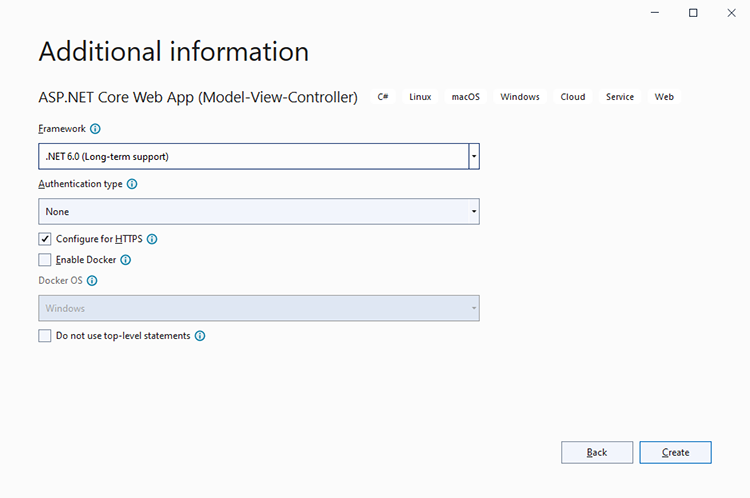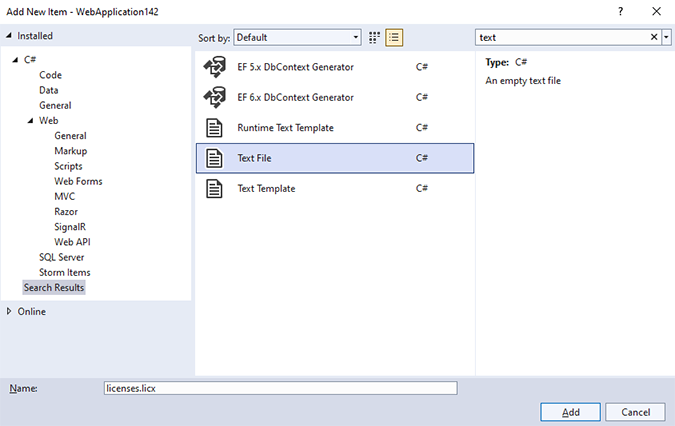TX Text Control .NET Server ASP.NET Guide Getting Started: ServerTextControl and MailMerge with ASP.NET MVC (.NET Framework)
This article shows how to use the TX Text Control ASP.NET ServerTextControl and MailMerge classes within an ASP.NET web application in Visual Studio 2022.
The source code for this example is contained in the following directories:
Make sure that you downloaded the latest version of Visual Studio 2022.
1. In Visual Studio 2022, create a new project by choosing Create a new project.
2. Select ASP.NET Web Application (.NET Framework) as the project template and confirm with Next.
3. Choose a name for your project, select .NET Framework 4.8 as the Framework and confirm with Create.
4. In the next dialog, choose MVC as the project template and confirm with Create.

1. While the project is selected in the Solution Explorer, choose Project -> Add Project Reference... to open the Reference Manager. In the opened dialog, select Browse... to select the required TX Text Control assemblies. Navigate to the installation folder of TX Text Control and select the following assemblies from the Assembly folder:
Repeat this step with the following assemblies from the Assembly/bin64 folder:
After selecting these assemblies, close the Reference Manager by confirming with OK.
2. While the project is selected in the Solution Explorer, choose Project -> Add New Item.... Select Text File, name the file licenses.licx and close the dialog by clicking Add.

Open the newly added file and add the following content:
TXTextControl.ServerTextControl, TXTextControl.Server, Version=34.0.1900.500, Culture=neutral, PublicKeyToken=6b83fe9a75cfb6381. Find the HomeController.cs file in the Controllers folder. Replace the Index() method with the following code:
public IActionResult Index() {
using (TXTextControl.ServerTextControl tx = new TXTextControl.ServerTextControl()) {
tx.Create();
// adding static text
TXTextControl.Selection sel = new TXTextControl.Selection();
sel.Text = "Welcome to Text Control
";
sel.Bold = true;
tx.Selection = sel;
// adding merge fields
TXTextControl.DocumentServer.Fields.MergeField mergeField =
new TXTextControl.DocumentServer.Fields.MergeField() {
Text = "{{company}}",
Name = "company",
TextBefore = "Company name: "
};
tx.ApplicationFields.Add(mergeField.ApplicationField);
// alternatively load a template
//TXTextControl.LoadSettings ls = new TXTextControl.LoadSettings() {
// ApplicationFieldFormat = TXTextControl.ApplicationFieldFormat.MSWord
//};
//tx.Load("template.docx", TXTextControl.StreamType.WordprocessingML, ls);
// merge fields with MailMerge engine
using (TXTextControl.DocumentServer.MailMerge mailMerge =
new TXTextControl.DocumentServer.MailMerge()) {
mailMerge.TextComponent = tx;
mailMerge.MergeJsonData("[{\"company\": \"Text Control, LLC\" }]");
}
// return result as HTML
string result = "";
tx.Save(out result, TXTextControl.StringStreamType.HTMLFormat);
// alternatively save as PDF
//byte[] baPdf;
//tx.Save(out baPdf, TXTextControl.BinaryStreamType.AdobePDF);
ViewBag.Document = result;
}
return View();
}1. Find the Index.cshtml file in the Views -> Home folder. Replace the complete file with the following code:
@{
ViewData["Title"] = "Home Page";
}
@Html.Raw(ViewBag.Document)Compile and start the application.